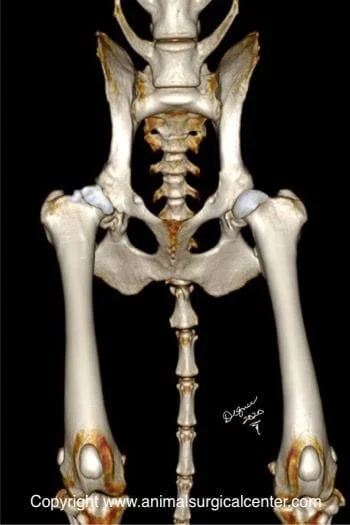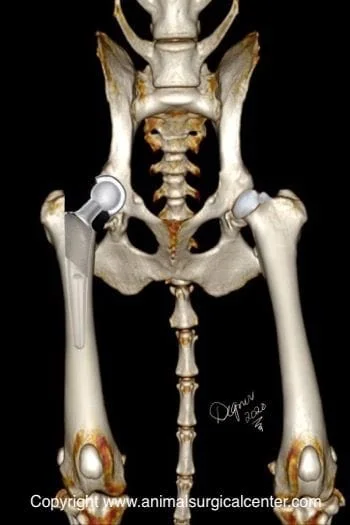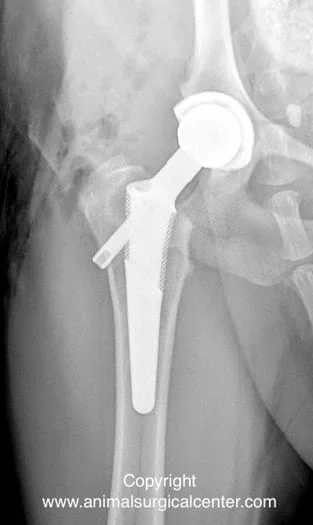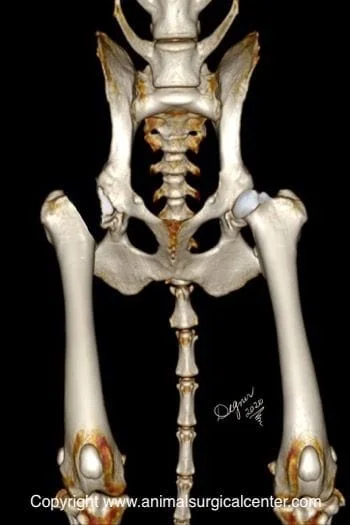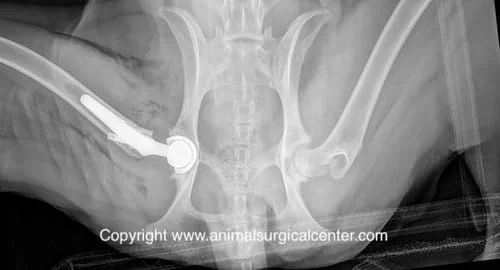Key Points
- Total hip replacement is an excellent treatment for dogs that have hip dysplasia
- The success rate of hip replacement is about 95%; the current complication rate at ASCM (as evaluated 2019-2022) is 4%
- Postop exercise restriction is essential in addition to good surgical technique for a successful outcome
Downloadable forms/information for clients for initial visit:
History sheet initial consultation for total hip replacement
Client education handout for total hip replacement
Discharge instructions for total hip replacement postop care
Recheck Evaluations
History form - 2 week Telemedicine recheck
History form - 12 week in hospital recheck
Downloadable forms for referring veterinarians:
Powerpoint DVM presentation for clients
Video of surgical procedure
Hip Dysplasia
Hip dysplasia is a developmental condition of the hip joint(s) which results in malformation of the hip joint(s) and arthritic changes. Looseness of the hips in young dogs may result in arthritis of the joints over a period of months to years. The illustration right shows an arthritic hip on the left and a normal hip on the right. Any breed can develop this condition, however large breeds are most commonly affected. Defective genetics result in looseness of the soft tissues and poor muscling which allow the head of the femoral head to slip in and out of the hip socket when a dog runs and plays. This wears the cartilage off the head of the femur and socket (acetabulum) of the hip. In addition, the soft hip bones in puppies become permanently deformed and the rim of the hip socket may develop small painful fractures.
Clinical signs of hip dysplasia
Dogs may be as young as five months when signs appear, others are older than one year, and some are geriatric. A waddling gait of the hind quarters when walking (hip sway), bunny hopping when running, a shortened stride of the hind limbs, lameness on one or both hind limbs, reluctance to jump on elevated surfaces and stiffness when first getting up from a nap are common signs. Clicking or popping sounds heard from the rear, exercise intolerance, crying out in pain when playing, and pain upon petting the hip region are signs that also may be present. An awkward gait frequently dismissed as a clumsy puppy may be a warning sign of hip dysplasia. Physical examination findings that your veterinarian may discover may include the following:
- Narrow-based gait
- Waddling gait
- Muscle atrophy of affected limb(s)
- Pain on extension or abduction of the hips
- Crunchy sensation (crepitant) upon range of motion of the hips
- Limited hip extension
- Loose hips (positive Ortolani sign)
- Hip dislocation
Diagnosis
Both orthopedic examination and x-ray images of the pelvis are used to establish a diagnosis of hip dysplasia. The patient is sedated to obtain correctly positioned x-ray images. From these x-ray images, the surgeon will determine if the pet is a candidate for total hip replacement (THR) and select appropriate-sized THR implants. Chronic hip dislocation, severely malformed or worn femur or acetabulum, bone infection, bone cancer, acetabular fracture, and excessive thickening of the proximal femur bone may be grounds to deny the patient from total hip replacement surgery.
Candidates for total hip replacement
The pet must be healthy and free of serious internal organ diseases. Skin infection, urinary tract infection, periodontal infection, flea infestation, chronic skin allergies, or any other body infection may preclude the pet from being a candidate for THR surgery. During spring and summer, biting flies can cause dermatitis and secondary skin infection that may temporarily deny your pet from THR. Cruciate ligament tear, a common condition that may mimic signs of hip dysplasia, should be ruled out prior to THR. Other orthopedic (as listed above in the diagnosis section) or neurologic causes of the lameness must also be ruled out prior to surgery.
Preparation for surgery
Total hip replacement requires a preoperative evaluation. Blood work is completed to ensure the health of the internal organs. One day before surgery, bathe the pet with chlorhexidine shampoo and they are not allowed to go outside except for elimination purposes so that the pet does not get dirty.
The pet should be fasted before surgery, as the surgical team instructed. Provide free access to water up to the time of admission to the hospital. Inform the surgical team of the medications that your pet is currently receiving. At the time of admission for surgery to our hospital, a patch of hair will be shaved off the hip region to examine the skin for infection. If dermatitis is present, we will cancel the surgery. Just before surgery, your pet will receive a sedative, have an intravenous catheter placed for the administration of intravenous fluids and intravenous medications, be induced under general anesthesia with medication(s), and have a breathing tube (endotracheal tube) placed to allow delivery of oxygen and gaseous anesthesia. The hind quarter will be clipped and cleansed with an anti-septic solution in preparation for surgery. While under general anesthesia, the pet’s breathing will be assisted with a ventilator. The anesthetist will monitor vital parameters such as heart rate, respiratory rate, core body temperature, blood pressure, oxygenation of the blood (pulse oximetry), exhaled carbon dioxide (capnography), and heart rhythm (EKG) to ensure the pet’s well-being. Your pet will receive pain-relieving medication during and after surgery.
Surgery
Total hip replacement (THR) is the preferred treatment for dogs with clinical signs of hip dysplasia or other debilitating hip diseases in cats, and all sizes of dogs. During the procedure, the surgeon removes the head portion of the neck of the femur bone. Next, the arthritic hip socket is reshaped with special reaming instruments, and a metal cup lined with durable plastic is positioned and impacted into the hip socket. The marrow cavity of the femur bone is opened and shaped with reamers and broaches to receive a femoral metal implant. The metal implant is impacted down the marrow cavity to achieve a press-fit. A metal ball is placed on the neck of the femoral stem implant, and the hip replacement components are fit together to form the artificial ball and socket joint (see above left and above middle images). The joint capsule, vital to keep the hip together, is sutured closed.
If your pet’s hip is unsuitable for THR, the surgeon will perform a femoral head and neck ostectomy (FHO), which involves the removal of the head and neck of the femur bone (see fig below right). Scar tissue will develop between the bones to form a false hip joint. Although FHO may not be the ideal treatment for a large breed dog, an acceptable outcome may be achieved with aggressive rehabilitation therapy.
Aftercare
Upon arrival at home, your pet may be tired from anesthetics or analgesics administered in our hospital. Some dogs may whine or act delirious, and this may be due to residual narcotics or anesthetic medications. These signs usually resolve by the following day. Expect the first two to three days after surgery to be the most difficult for the pet. Follow these instructions after surgery for the best recovery:
- Continue to give your pet a prescribed pain reliever to minimize discomfort.
- Take your pet outdoors for elimination even if they do not ask, as a full bladder will make them uncomfortable and whine.
- Give a laxative such as Miralax if the stool is not passed for four days after surgery. Bowel movements may not be produced for a few days after surgery.
- If needed, entice the appetite with a home-cooked meal of lean meat and rice may be offered.
- Administer prescribed antibiotics to prevent infection.
- Limit exercise to short leash walks. Running, jumping, chasing, off-leash activities, and playing with other canine mates are prohibited for three months.
- Cover slippery floors in the home with carpet to provide good footing and minimize the risk of an accidental fall.
- Complete the rehabilitation exercises at your home for six weeks after surgery.
- Your pet’s surgeon will monitor the healing process with follow-up examinations at two weeks and 12 weeks after surgery. During the second appointment, x-ray images of the pelvis will be evaluated for bony ingrowth onto the THR implants.
- Notify the surgeon if your pet sustains acute lameness as soon as possible.
Long-term prevention of infection
For the life of your pet, continue good oral hygiene to prevent infection. The primary care veterinarian should perform dental prophylaxis on the pet twice yearly. Monitor your pet for signs of infection and treat such conditions immediately. Prophylactic intravenous antibiotics should be given 30 minutes before the procedure, and oral antibiotics should be prescribed for seven days. These precautions will help to minimize the risk of THR infection.
Complications
Complications of total hip replacement may include:
- Infection.
- Loosening of the implants.
- Sciatic nerve damage.
- Fracture of the femur or hip socket.
- Dislocation of the hip.
Most serious complications occur within the first two weeks after THR.
If acute lameness develops after surgery, the pet must be evaluated by the pet's surgeon with a clinical examination and pelvic x-ray imaging.
Success
In 136 consecutive total hip replacement cases performed at ASCM over three years (2019 to 2022), the complication rate was 4.1%. The most common complication was hip dislocation seen in three dogs in this series. Other complications included one dislodged acetabular cup, one femoral fracture and one infection. Four of six of the above patients had a successful revision surgery and two patients needed the removal of the THR implants. Client satisfaction is also rated very high in our clinical cases.
Case example 1
In the video below is a typical recovery at one week after surgery; take note that Kai is bearing weight very well on the limb.
Case example 2
Luna had left THR two years ago and right THR two weeks ago and is doing very well.


